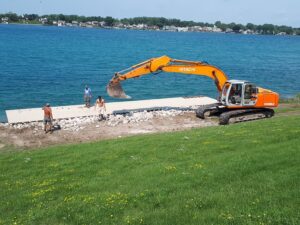Southwestern First Nation connecting severed ties with water

By Colin Graf
AAMJIWNAANG FIRST NATION— Community members will soon be able to enjoy walking down to the banks of the St. Clair River for a family gathering, swim, and even a barbecue, as two new boardwalks are about to open along the First Nation’s ancient highway and life-giver.
The two walkways, each stretching around three metres into the river, will be the latest additions to help build new connections to the river that were severed for many years, says Aamjiwnaang Environment Coordinator Sharilyn Johnston.
The new boardwalks, one each at the north and south ends of a two-kilometre stretch of River Road, will stretch about three-metres into the river, with the north about 18-metres long, and the south about nine metres, Johnston says.
The pathways will enable the community to “go out there and sit, play some music, sit on chairs, be with family and swim if they want, have a little barbecue. It just allows them to sit out by the water and experience the connection they used to have,” she explains.
People have expressed the wish to have more river access, Johnston says, as erosion controls installed in the 1970s blocked the way.
“They all had docks in the fifties and sixties,” Johnston has been told through community consultation, and members “have been wanting this for quite some time; they want their access back,” she says.
The large rocks that were installed as erosion control have served little purpose in recent years, as high water levels have almost covered them. Some are being pulled back to new positions to protect the riverbank near the boardwalks, Johnston adds.
The community has been waiting a long time for this, Johnston says.
“Finally the community can have that connection back which they’ve been asking for a long time. That connection means being able to sit by the water, being able to respect the water, being able to look at the changes in the water, being able to fish, being able to gather,” she relates. “It’s reinstating that personal connection. The spiritual connection has always been there, but it’s been at a distance. Now it’s where they can gather and actually touch the water.”
The boardwalks will be accessible by stairs, but a $95,000 grant from the government of Canada will pay for a wheelchair-accessible ramp to be built as well, Johnston says. The boardwalks are costing around $56,000, and are being paid for by community benefit agreements with petrochemical companies Suncor and Shell, which have plants nearby.
The boardwalks are the latest in a series of construction works that have made the river more accessible to Aamjiwnaang. A length of shoreline was “softened” in 2017 by replacing sheet metal pilings with tiers of stone, grass, and aquatic plants to naturalize the riverbank, making access easier.
A new fishing pier was installed in 2018 to make fishing easier and more comfortable. The pier also provides shade for fish habitat underneath and access to deeper water for fishers. The pier has been a real hit, Johnston says.
“Everybody loves it, everybody uses it, it’s been one of those things where everybody just is so happy for it now. We’ve had nothing but good comments.”
Aamjiwnaang started a new policy in 2017 to allow only community members to fish from the riverbank, a location popular also with people from the adjacent city of Sarnia. Community members were being crowded out by the visitors, especially at peak fishing time during summer evenings, according to then-Chief Joanne Rogers.
Workers aim to complete Aamjiwnaang’s new north boardwalk on the St. Clair River by September. The new pathway by the river, along with another near the south end of the territory, will be a place to sit and enjoy the sights and sounds with friends and family.


